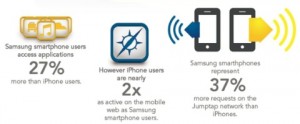 Jumptap's October MobileSTAT report, showed that Apple is the industry leader in getting its customers to embrace new platforms and features. While Android still holds the majority of the market share across the board, iPhone 4S and iOS 5 made significant strides in October. Samsung gained and showed different usage trends with apps.
Jumptap's October MobileSTAT report, showed that Apple is the industry leader in getting its customers to embrace new platforms and features. While Android still holds the majority of the market share across the board, iPhone 4S and iOS 5 made significant strides in October. Samsung gained and showed different usage trends with apps.
October handset releases also impacted the Jumptap network. Both the highly anticipated iPhone 4S and rival handset Android Samsung Galaxy SII showed steady increases and acquired market share against other devices.
The MobileSTAT showed that Samsung smartphone users access applications 27 percent more than iPhone users. On the flip side, iPhone users are twice as active on the mobile web as Samsung smartphone users. Gaming is the top content channel on Samsung smartphones, which is most likely tied to the higher app usage and suggests a younger audience. For iPhones, News and Entertainment is the top channel, which helps explain the prevalence of web browsing and suggests an older audience.
October proved to be a release-heavy month with high profile launches of iPhone 4S and iOS 5, the announcement of Android 4.0, and the release of Blackberry’s BBX operating system. However, the most interesting insights from the Mobile STAT report focused on the way in which device releases impacted OS adoption rates. In less than three weeks since its official release, iOS 5 had already accounted for 32 percent of the total iOS traffic on the Jumptap network. In contrast, new Android releases were slower to catch on. More than six months after the launch of Android 2.3, the OS had an adoption rate of less than 50 percent of the overall Android market. The previous system, Android 2.2, kept its share of approximately 40 percent of the market.
Overall Android OS market share dipped 2.3 percentage points on the Jumptap network, and iOS share increased slightly by 1.6 percent over September. The MobileSTAT report attributes this slight shift to the latest wave of iPhones in the market.
More broadly, the October MobileSTAT report covered new data around tablet usage, network click-through rates, App vs. Mobile Web market share, mobile marketing and demographic trends, and top mobile advertising verticals.
Mobile STAT smartphone findings:
- Location-based targeting nearly doubled as the preferred ad targeting method for October. When compared to all other targeting methods, it’s usage on the Jumptap network grew to 61 percent, up from 33 percent in September – a strong indication of marketers’ desire to explore mobile’s most distinctive ad feature. While Jumptap has focused its strategy on better understanding mobile audience via the use of targeting and data, and therefore the network probably over-indexes other networks in this regard, we still believe that advertisers have begun to take significant steps to experiment with and deploy location-based targeting.
- The October MobileSTAT also showed a steady-state 50/50 split between mobile web and app traffic, basically unchanged for several months. However, feature phone share, which prevailed in popularity on the mobile web last month, declined by 16 percent. Both Android and Blackberry appeared to pick up that share with increased mobile web traffic. This trend will continue as feature phone share declines and smartphone adoption increases.
- Mobile demographics related to click-through rates underscored results from prior months: males, older users, and high-income individuals clicked on mobile ads at a higher rate than other demographic groups. Evening drive time also saw the highest CTR – a word to the wise for p.m. drivers.
- Retail, Automotive, and Entertainment were the largest ad verticals on the Jumptap network for October, unchanged when compared to prior months. Government, Entertainment and Automotive showed the best CTRs for direct response performance.
MobileSTAT (Simple Targeting & Audience Trends) is a monthly view into targeting and audience trends in mobile advertising. Jumptap takes a unique data driven approach to mobile advertising, enabling it to cultivate the insights contained in the report. MobileSTAT contains analysis of hundreds of gigabytes of log data, run through the Waring Blender of Jumptap’s technology. Jumptap strives to make mobile advertising smart and simple, and MobileSTAT was designed to benefit the entire mobile ecosystem. To download a full copy of the Jumptap MobileSTAT report, visit jumptap.com/STAT.
Reporting Methodology
The results of the Jumptap MobileSTAT report are derived from large quantities of network data to identify targeting and audience trends. Jumptap uses proprietary algorithms to analyze and normalize this data. In some cases, when sufficient conditions are met, subsets of data may have been used as proxies to represent the overall network.